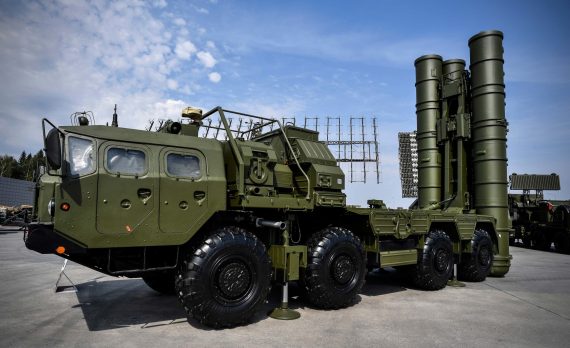The evolving uncertainties of world politics and diverse forms of threats have compelled Turkey to take new decisions in terms of strategy. There are both realized and impending changes that are to follow these tendencies in order to establish partial alliances and to increase the capacity of strategic weaponry. In this respect, the S-400 missile system is at the junction of the aforementioned two trends.
Global fluctuations and security threats evolving around Turkey requires the country to be prepared for multiple risks. While new phenomena, such as using terrorism as a weapon and proxy wars have emerged, these have not completely eradicated the concept of conventional war. Therefore, precautions against conventional and nuclear warfare are as vital as those taken against terrorism. In this respect, the threats Turkey has faced in the last 7 years, especially those after June 2015, are striking.
Allocating events in chronological order might provide some clues about the bigger picture: In June 2012, a Turkish military aircraft was downed and in response, the air defense systems demanded from NATO were placed six months later. Turkey changed its rules of engagement and transitioned into an alert state. Later in March 2014 and November 2015, Turkey downed a Syrian and a Russian military aircraft, respectively. While the PKK declared autonomy in Syria, Daesh was on the border of Turkey, and the YPG/PKK threat become more prominent after Daesh’s attack to Ayn al-Arab. After the said siege, Daesh bombarded Turkish soil with mortars and rockets. By the end of 2015, Russia placed S-400 missile systems in Syria. Turkey was at the brink of war with Russia after the downing of Russian military aircraft. Following the June 7 elections, the PKK started to commit terrorist attacks in Turkish cities. The terrorist organization tried to gain ground through its “trench strategy.”
First Germany then the US withdrew their Patriot air defense missile systems from Turkey. In other words, they left Turkey vulnerable to attacks from terrorist organizations and other international actors.
Amongst these crises and attacks, first Germany then the US withdrew their Patriot air defense missile systems from Turkey. In other words, they left Turkey vulnerable to attacks from terrorist organizations and other international actors. Turkey fought against these threats on its own and incapacitated many of them. The most prominent consequence of these series of events was Turkey’s further advance into the defense industry – there were also certain initiatives in the past years in this respect.
While on one hand the Turkish administration accelerated the production of weapons with use of its own resources, the government preferred to buy products, such as defense systems, whose production and usage is feasible in the long-run, from other countries. While the pursuit to acquire defense systems goes back to the 90s, an important step in this regard was taken by announcing a tender for the procurement of such systems. With the ultimate aim of protecting its own territory, the conditions declared that Turkey also placed importance on common production and technology transfer. While these conditions suspended the financial burden of such systems, the condition of “50% joint production” was a premise for developing, diversifying and nationalizing the imported defense system in the following years. While the Chinese company CPMIEC satisfied the requirements of the Turkish administration and thus won the bid, the process was later cancelled in September 2015, as it was announced that Turkey decided to initiate the process of producing its own long-range missiles.
The Process of Procuring S-400s
After 4 years, Turkey was back to square one in terms of air defense systems. Comments made by Western politicians and military figures along with the discussions in the public sphere were reminiscent of what can be called a “déjà vu” – Same arguments, similar statements! Not so concerned about the country’s national security, the western public sphere, media and bureaucracy once again diverted their criticisms towards Turkey. This attitude is embodied in the statement made by the US Chief of Staff, merely “concerning.” This matter was also up to debate in the US Congress, and the purchase of S-400s were described as “worrying.” Ironically however, it is also a US Special Forces commander who is able to mockingly state that they advised the YPG to change their name. More, it is the US that supplies the YPG in Syria with weapons that many countries do not even possess. The US can only guarantee by word of mouth that these weapons will not be used against Turkey. This reminds us of the withdrawal of Patriot air defense missiles from Turkey, as discussed earlier. It can strongly be stated that, the guarantees provided by these actors in regards to Turkey’s fight against threats it faces is only bound by words. Hence therefore, Turkey has to take necessary precautions.
Responding to a question asked by reporters on the way back from his Gulf tour in July, 2017, President Erdoğan stated that negotiations for the S-400 defense system was coming to an end. Following, during the second week of September, Erdoğan announced that the agreement was almost complete and that a deposit payment had been made to Russia. The cost of this system for Turkey is going to amount to approximately US$2.5 billion. The first two systems and its equipment will be transported from Russia to Turkey, while the rest of them will be produced in Turkey. Nowadays, there are reports that an intensive work process is continuing for S-400s to be placed and become ready for use in Turkey. Since the emergence of the issue into the public agenda, many questions have begun to be debated intensively. These are the main questions:
How does an S-400 function and what are its features?
What is an S-400 defense system? Why does Turkey need it? Is it possible to integrate with NATO? Does this preference mean that Turkey has detached from the West on a political level? Is co-production and technology transfer possible in the short term?
Recommended
The main function of an air defense system is to detect and destroy attacking aircraft and ballistic missiles. In general, the system has four stages of operation: detection, identification, tracking and destruction. The only defense system that has the ability to detect a missile from its launch and destroy it out of the atmosphere is currently possessed by the US alone. The US realizes this tracking system through satellites. Other systems are usually able to detect and destroy missiles after they enter a certain range. The length of this range can vary depending on the radar support of the defense system. For instance, NATO has numerous command centers, radar systems and missile launchers deployed in very large and diverse locations.
The system works as a whole. Simply put, satellites, or the radar system in Kürecik detects a missile, relays the information to the command center in Germany and the battleships in the Mediterranean destroy the missile.
One of the questions raised at this point is whether this system will be integrated into NATO. When reviewing different explanations made at different times in this regard, Turkish experts stated that they could create an interface for the defense system that was to be acquired from China, which would allow integration with the NATO system. This is also true for the S-400 defense system. The latest statement made by the NATO Secretary General is also significant in this respect. While Stoltenberg stated that member states were free to acquire any equipment they wanted, he did not make a technical statement about NATO compliance. He only mentioned that this matter could be discussed in case of such a demand. This indicates that the will of respective parties will be the determining factor in this matter. It is certain that there will be many concerns and drawbacks. For instance, US military experts are talking about the possibility of Russia accessing NATO data by manipulating the system. It is important to note that this disclosure is directed at the public, as the system has not yet been tested in this sense. Moreover, the deployment of S-400s in Turkey does not account for the dismissal or replacement of NATO.
Will the S-400s not integrated into NATO remain completely dysfunctional?
This question is answered with a “yes” quite boldly. Although the reasons are not explained, it is asserted that S-400 defense systems that are not integrated with the NATO system will be unable to detect and destroy ballistic missiles. However, although the radars integrated into the S-400 system do not have satellite capability, they are able to destroy missiles in the specified range, as illustrated in Table 1. Moreover, S-400 defense systems can also detect all kinds of hostile aircrafts, ranging from fighter jets and heavy bombardment aircrafts to UAVs. Turkey’s primary technical aim is to reconfigure the detection system according to its own military doctrine and friend-or-foe definition.

In this respect, it could be asserted that S-400s have the capacity to satisfy the needs of Turkey in the short-term. Naturally, advanced defense systems that are integrated with satellites could be preferred. However, as stated earlier, only the US possesses such systems and they are reluctant to sell them. Turkey’s preference of S-400s is not limited to facilitating its security in the short-term. The publicized information suggests that work on joint production, technology transfer and human resources are prominent aspects of this agreement. While the details of the agreement are yet to be announced, it is definite that the first batteries will be transported from Russia and the remaining batteries (50%) are to be produced in Turkey. Therefore, this procurement will allow Turkey to establish an infrastructure for defense systems in the long-term.
Air defense system is a must for Turkey
Considering the transformation of international politics and the emerging potential of threats posed, Turkey’s need for a defense system is urgent. The preference of S-400s was thus shaped within the framework of Turkey’s needs and the positions of its allies. It was frequently expressed that the first offers were made to the Western allies of Turkey in respect to eliminating this need. However, the US and other NATO allies’ reluctance to sell or jointly produce these defense systems had the potential to increase Turkey’s dependency. Therefore, Turkey’s preference of S-400s as an alternative is partially an outcome caused by the attitude of its allies.
The point to be questioned here is that although Turkey has been a NATO member since 1952, and the closest to the Soviet threat in terms of proximity, the country still does not have a defense system and is totally dependent in this area. The circumstances of the Cold War are now irrelevant as the threat is not posed by a single actor. Turkey is not a country that could ensure its security by being completely dependent on either NATO or Shanghai. A Turkey failing to achieve independence in terms of defense and offense can never become a true global actor. In short therefore, Turkey’s quest for a defense system and its insistence on S-400s should be regarded within this framework.





